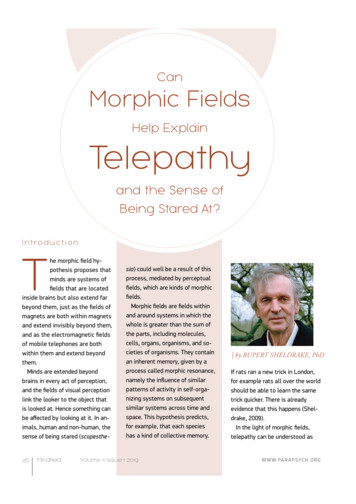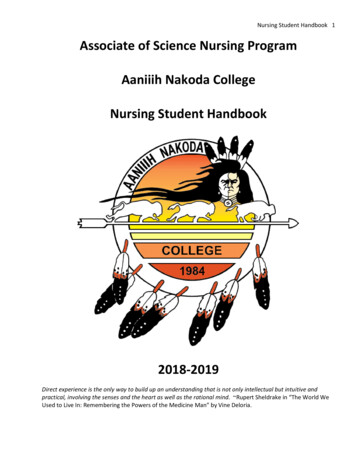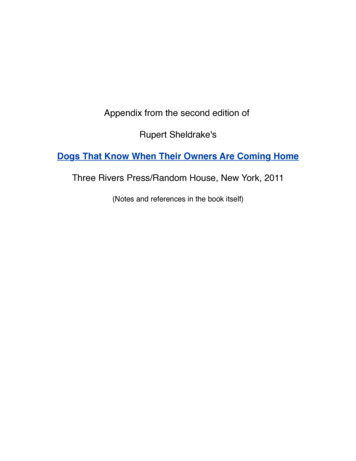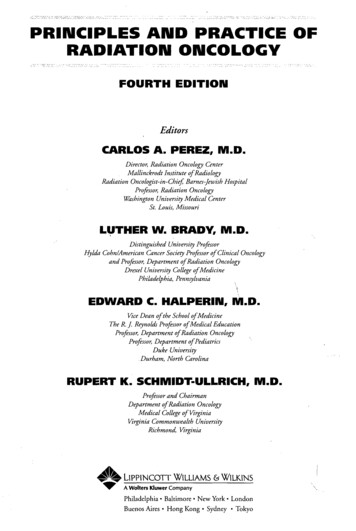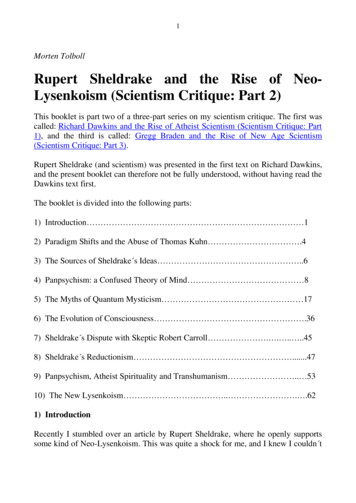
Transcription
1Morten TolbollRupert Sheldrake and the Rise of NeoLysenkoism (Scientism Critique: Part 2)This booklet is part two of a three-part series on my scientism critique. The first wascalled: Richard Dawkins and the Rise of Atheist Scientism (Scientism Critique: Part1), and the third is called: Gregg Braden and the Rise of New Age Scientism(Scientism Critique: Part 3).Rupert Sheldrake (and scientism) was presented in the first text on Richard Dawkins,and the present booklet can therefore not be fully understood, without having read theDawkins text first.The booklet is divided into the following parts:1) Introduction 12) Paradigm Shifts and the Abuse of Thomas Kuhn .43) The Sources of Sheldrake s Ideas .64) Panpsychism: a Confused Theory of Mind 85) The Myths of Quantum Mysticism 176) The Evolution of Consciousness .367) Sheldrake s Dispute with Skeptic Robert Carroll . . . .458) Sheldrake s Reductionism .479) Panpsychism, Atheist Spirituality and Transhumanism . 5310) The New Lysenkoism . . .621) IntroductionRecently I stumbled over an article by Rupert Sheldrake, where he openly supportssome kind of Neo-Lysenkoism. This was quite a shock for me, and I knew I couldn t
2let it go. I realized that my previous article on Sheldrake had to be revised, and that Ihad to do a bit more research. Then I discovered his almost complementaryrelationship with Richard Dawkins. Remember: Dawkins s most notorious work iscalled The God Delusion. As an answer to this Sheldrake has written a counterwork: The Science Delusion. Richard Dawkins is a head figure in the skepticalmovement (which claims to represent real science), and Sheldrake has in fact createda counter-skeptical movement, consisting of New Agers (the new, real scientists,according to him).Who is Rupert Sheldrake? On his website he is described like this:Rupert Sheldrake, PhD, is a biologist and author best known for his hypothesis ofmorphic resonance. At Cambridge University he worked in developmental biology asa Fellow of Clare College. He was Principal Plant Physiologist at the InternationalCrops Research Institute for the Semi-Arid Tropics in Hyderabad, India. From 2005to 2010 he was Director of the Perrott-Warrick project for research on unexplainedhuman and animal abilities, funded by Trinity College, Cambridge.The fact is that Rupert Sheldrake is a former scientist (very former, as in not doingscience any more) who, since the 1980s, has preferred to promote his own theory ofeverything called "morphic resonance". Sheldrake believes that "memory is inherentin nature" and that "natural systems, such as termite colonies, or pigeons, or orchidplants, or insulin molecules, inherit a collective memory from all previous things oftheir kind", and that this "morphic resonance" also explains "telepathy-typeinterconnections between organisms". He has written several books targeted at thegeneral public.In his book, Science and Spiritual Practice, he writes:When I was thinking that about how morphogenetic fields might be inherited, a newidea occurred to me: there might be a kind of memory in nature giving connectionsacross time from past to present organisms, providing each species with a kind ofcollective memory of form and behavior. I called this hypothetical transfer of memorymorphic resonance (page 6).Sheldrake has devoted much thought and speculation towards trying to find causesfor some of life's more peculiar and spooky occurrences: such as how dogs seem toknow their owners are coming home, how separated siblings sometimes seem toexperience symptoms of the other's illness despite living in a different continent, andhow it takes bloody ages to try and get a protein to crystallize, but once one labmanages it, lots of others seem to be able to with ease.
3Science generally has no explanation for observations of such happenings, and indeedscientific knowledge could suggest there can be no causal reason for them and theyare simply flukes and/or people seeing patterns which are not there. Sheldrake,however, has developed the concept of the "morphic fields" in an attempt to "explain"them.According to his 1981 book A New Science of Life, such a field would make it so thatonce a species has evolved, the next species to evolve would look something like it,apparently due to the Universe having a memory since it is alive.Morphic resonance is extremely vague and ill-defined, and can only really bedescribed as whatever Sheldrake says it is. Crucially, it is not falsifiable, andtherefore not testable (although some have tried). It is therefore an example ofpseudoscience.RationalWiki writes:1) Sheldrake describes himself as having been a "Research Fellow of the RoyalSociety". The Royal Society's Research Fellowship — essentially a grant forresearchers in the early stages of their research career — can easily be confusedwith the highly prestigious election to the Fellowship of the Royal Society. Sheldrakehas not been elected FRS.2) Some of Sheldrake's work has been funded by the Perrott-Warrick Project, a fundset up in the early-20th century to fund research in parapsychology, which Sheldrakepoints out is "administered by Trinity College, Cambridge". However, theinvolvement of Trinity is limited to organising the finances — nobody at Trinity hasany involvement with the committee that decides how the money is spent, andconsequently Sheldrake has held no position on the faculty at Trinity. The thenMaster of Trinity, Lord Rees, has on the record disowned Sheldrake and distancedhim from Trinity, playfully suggesting that as a former fellow of Clare College, it wasClare that should receive "undiluted credit" for his work.3) Sheldrake claims to have authored "more than 80 articles in peerreviewed heldrake/frequentlyasked-questions]. However, excluding articles in pseudojournals that clearly weren'tpeer reviewed, the true number is actually less than half (helpfully they're on hiswebsite so you can count 'em). He hasn't published any peer reviewed research sincethe mid-1980s.
4These facts don't stop media organisations from incorrectly referring to him ininaccurate and flattering terms. Even the BBC, who should know better, referred tohim as "Professor Rupert Sheldrake". The Daily Mail, who often don't know betterreferred to him as a "Cambridge University Biologist". His own publishers referredto him as "one of the world's most preeminent biologists".RationalWiki is itself, however, probably one the “skeptical” medias whichSheldrake doesn t like (see the ebook on Dawkins, or below).2) Paradigm Shifts and the Abuse of Thomas KuhnRobert Carroll (another skeptic Sheldrake doesn t like) writes in The Skeptic sDictionary:Morphic resonance is a term coined by Rupert Sheldrake in his 1981 book A NewScience of Life. He uses the expression to refer to what he thinks is "the basis ofmemory in nature.the idea of mysterious telepathy-type interconnections betweenorganisms and of collective memories within species."Among his early influences Sheldrake cites The Structure of ScientificRevolutions by Thomas Kuhn (who is a philosopher of science). Sheldrake says thatthe book led him to view contemporary scientific understanding of life as simplya paradigm, which he called "the mechanistic theory of life". Reading Kuhn's work,Sheldrake says, focused his mind on how scientific paradigms can change.It can sound confusing when I speak about New Age as part of the anti-sciencemovement, since New Age seems obsessed with science, and call everything theythink and do, for science. But that is because they demand so-called “alternativesciences”, which breaks with “old-fashioned science”. As an alternative to atheistscientism, New Age offers a “New Science”, which basically is a kind of “New AgeScientism”. We simply have to do with George Orwell s concepts of “old-thinkingand new-thinking”. This is not a baseless comparison, as we shall learn in thisbooklet. The reason for this is to be found in postmodernism, which is the intellectualbackground for New Age. I will return to this.Therefore, they are also obsessed with the concept of paradigm shifts.The concept of paradigm shifts comes from the philosopher of science: ThomasKuhn. And Sheldrake reads Thomas Kuhn in the same way as numerous other NewAgers, namely as if he provides a model, blueprint, or seal of approval, for creating
5paradigm shifts! Combined with postmodern subjectivism and relativism, this meansthat everything is allowed, and everything can be stated as being science.Example: one of the founders of Neuro-linguistic Programming (NLP) John Grinderdenies, that his and Bandler s work is an eclectic hodgepodge of philosophy andpsychology, or that it even builds from the work of others. He believes that what heand Bandler did was “create a paradigm shift.”The following claim by Grinder provides some sense of what he thinks NLP is:My memories about what we thought at the time of discovery (with respect to theclassic code we developed – that is, the years 1973 through 1978) are that we werequite explicit that we were out to overthrow a paradigm and that, for example, I, forone, found it very useful to plan this campaign using in part as a guide the excellentwork of Thomas Kuhn (The Structure of Scientific Revolutions) in which he detailedsome of the conditions in the midst of paradigm shifts. For example, I believe it wasvery useful that neither one of us were qualified in the field we first went after –psychology and in particular, it s therapeutic application; this being one of theconditions which Kuhn identified in his historical study of paradigm shifts. Whoknows what Bandler was thinking?One can only hope that Bandler wasn t thinking the same things that Grinder wasthinking, at least with respect to Kuhn s classic text.Kuhn did not promote the notion that not being particularly qualified in a scientificfield is a significant condition for contributing to the development of a new paradigmin science. Furthermore, Kuhn did not provide a model, blueprint, or seal of approval,for creating paradigm shifts! His is an historical work, described what he believed tohave occured in the history of science. He made no claim that anything similarhappens in philosophy and he certainly did not imply that anything NLP did, or isdoing, constitutes a paradigm shift (read more about the inspiration from Kuhn in myarticle Constructivism: the postmodern intellectualism behind New Age and the selfhelp industry - postmodernism is also Rupert Sheldrake s intellectual background, aswe shall see).The bridge between science and spirituality is an expression you hear all the timewithin New Age. And they try to create “alternative sciences” all the time. Each newnumber of a New Age magazine or New Age promoting website with respect foritself, must contain at least one new “revolutionary” new “scientific” theory, which isthe beginning to a “paradigm shift” in science. The number of new forms of“alternative sciences” within New Age is therefore today almost comically large.
6So, the “bridge” in New Age is built of sand, namely pseudoscience grounded in antiintellectualism and anti-science.But could you in fact talk about such a bridge? Yes, and that is philosophy. I havetried to point that out several times, with minimal success (read more in myarticle The Bridge Between Science and Spirituality).3) The Sources of Sheldrake s IdeasSheldrake's early career showed a lot of promise. A grammar school boy, he went toCambridge University to study biology. A degree was followed by a Ph.D., and thensome post-doctoral work; he was elected a Fellow of Clare College. Had hecontinued along the standard career path, and engaged in conventional research, hemay well have become a quite respected professor.However, in mid-career, and over a gradual period starting in the late-1970s andfinishing in the mid-1980s, Sheldrake dropped out of engaging in the scientificprocess. He has held no academic positions since then.The dropping out process started with a career break travel to India, where he spentsome time in a Christian monastery. Then, instead of returning to his originalresearch programme, he wound up doing crop physiology research for an agriculturalinstitute in India — considerably less prestigious than world-renowned Cambridge.RationalWiki writes:He also discovered that instead of doing real science, writing books about New Agewoo was much more profitable.However, this is not a fair, or precise description (RationalWiki delivers goodmaterial, but also a lot of distortions – for example their use of the words “woo” andeven “bullshit” is so irrational as it can be). Sheldrake s works are in my viewbrilliant examples of writing, but it is also a fact that he is a child of thecounterculture, and is a hard bitten left-wing ideologist. His works are postmodernistideology, and, as we know, postmodernism is old University Marxism and Stalinismin new clothings. Sheldrake is an open advocate of Neo-Lysenkoism. We shall returnto this.Sheldrake says that although there are similarities between morphic resonance andHinduism's akashic records, he first conceived of the idea while at Cambridge, before
7his travel to India where he later developed it. He attributes the origin of his morphicresonance idea to two influences: his studies of the holistic tradition in biology, andFrench philosopher Henri Bergson's book Matter and Memory. He says that he tookBergson's concept of memories not being materially embedded in the brain andgeneralized it to morphic resonance, where memories are not only immaterial but alsounder the influence of the collective past memories of similar organisms.In the same style as with other New Age "scientists", none of Sheldrake's ideas arehis own (this is by the way also the case with Richard Dawkins). In his book A NewScience of Life the reader can get a good understanding of where he has pulledhis paranormal ideas from. He was influenced by the "organismic" philosophy ofAlfred North Whitehead, the vitalism of the biologist Hans Driesch who proposed theexistence of a life-force in organisms called "entelechy" (pp. 48-50) andthe Lamarckism of the psychologist William McDougall (pp. 188-194).In 1960, Ninian Marshall published a paper titled ESP and Memory: A PhysicalTheory. In the paper he proposed a hypothesis of "resonance", which basically saidthere is some kind of mysterious energy in nature that can explain biologicalmysteries and telepathic experiences. It's clear that Sheldrake's "morphic resonance"was influenced by this paper. In his book Sheldrake mentions the Marshall paper onlyin a footnote (p. 210) but admits that his own idea is similar to it in "severalimportant" ways.While his colleagues at Cambridge were not receptive to his idea, Sheldrake foundthe opposite to be true in India. He recounts his Indian colleagues saying, "There'snothing new in this, it was all known millennia ago to the ancient rishis." Sheldrakethus characterizes morphic resonance as a convergence between Westernand Eastern thought, yet found by himself first in Western philosophy. This is anexample of the same thing which Gregg Braden does. The so-called “bridge betweenscience and spirituality”, which Sheldrake and other New Agers claim to be creating,is in reality a reduction and distortion of the sources they have their ideas from. InBraden s case I would call it cultural appropriation.Sheldrake has also noted similarities between morphic resonance and CarlJung's collective unconscious, with regard to collective memories being shared acrossindividuals and the coalescing of particular behaviours through repetition, describedby Jung as archetypes. However, whereas Jung assumed that archetypal forms weretransmitted through physical inheritance, Sheldrake attributes collective memories tomorphic resonance, and rejects any explanation of them involving what he terms"mechanistic biology".
84) Panpsychism: a Confused Theory of MindSheldrake also advocates a philosophy of mind called panpsychism. It is a particularvariant of the general double-aspect theory of mind. Philosophy of mind is actuallyone of his central issues when he is participating in documentaries, etc. It is here hisobjection to materialism is seen (materialism denies the existence of consciousness).And that is praiseworthy.But Sheldrake s advocacy of panpsychism is problematic.Panpsychism is a part of the so-called double-aspect theory. In philosophy ofmind, double-aspect theory is the view that the mental and the physical are twoaspects of, or perspectives on, the same substance. It is also called dual-aspectmonism.Panpsychism is the view that mind or a mind-like aspect is a fundamental andubiquitous feature of reality. Panpsychism is one of the oldest philosophical theories,and has been ascribed to philosophers including Thales, Plato, Spinoza, Leibniz,William James, Alfred North Whitehead, Galen Strawson and David Chalmers.During the nineteenth century, panpsychism was the default theory in philosophy ofmind, but it saw a decline during the middle years of the twentieth century with therise of logical positivism. The recent interest in the hard problem ofconsciousness has revived interest in panpsychism.Panpsychism in its modern version has nothing to do with the pre-modern versions.Let me explain.As I have described on my page, Meditation as an Art of Life, Greco-Romanphilosophy was a spiritual practice. The different schools of philosophy in antiquitywere schools of enlightenment. This has been completely distorted by modernphilosophy.In his book, Philosophy and Theurgy in Late Antiquity, Algis Uzdavinys writes:Ancient Hellenic and modern European ’philosophy’ have nothing in common but thename. Ch. C. Evangeliou therefore contents the uncritical assumption that ancientHellenic philosophy is the origin of Western or European ‘philosophy’, arguinginstead that the Socratic tradition, to which Plato and Aristotle belong, has moreaffinity with the Egyptian wisdom and the ‘remote philosophies of India and China’.
9Within Christianity these schools of enlightenment continued in Christian Mysticism.Officially, religion and philosophy were divided into theology and science. So,science is a direct result of the meeting between Greco-Roman philosophy andChristianity. Philosophy itself developed hereafter into the abstract discourse, whichwe know today. The only direction within modern philosophy which slightly remindsabout philosophy in its original meaning, is existentialism. But existentialism has cutthe spiritual aspects away.In Greco-Roman philosophy there therefore existed a notion of enlightenment,precisely as in Eastern philosophy.In his book, Philosophy as a Rite of Rebirth – From Ancient Egypt to Neoplatonism,Algis Uzdavinys gives an idea of it:According to Aristotle (De Philosoph, fr. 8), wisdom (Sophia) covers any ingeniousinvention and conception (all of which ultimately are gifts, sent down by the gods);therefore to do any thing well, skillfully, according to the divine paradigms andmodels, is to follow the way of “wisdom” which finally leads to the highestmetaphysical goals, to the noetic realms where Wisdom itself, the graceful goddess,dwells. No wonder that every nation loves wisdom and has certain “lovers ofwisdom” [philosophers], be they goldsmiths, artists, healers, singers, priests, ormagicians.The concept of enlightenment was removed from both official (exoteric) Christianityand philosophy. Today, Western philosophy only works with the ordinary mind. Ithas no notion of the enlightened consciousness. It therefore also only works with twoways of attaining reliable knowledge: by reason (rationalism) or sensation(empiricism), or both (realism), They don t work with the third notion: meditation. InEuropean philosophy there has been, as a result of the above, a strong tradition foronly accepting these two ways of attaining knowledge: sensation and reason. In thesame way in philosophy of mind. The mind, which Western philosophers of mind istalking about, is the ordinary mind, not the enlightened consciousness. In Westernphilosophy of mind, the concept of enlightened consciousness simply doesn t existanymore after Greco-Roman philosophy. But even the descriptions of Greco-Romanphilosophy are based on modern reductive and selective thinking. Greco-RoamnPhilosophy is described by the means of positivism, as the first naive attempt ofmoving from religion (childish superstition) to science (adulthood).In Sheldrake s books, you will hear the distorted claim, that the concept ofpanpsychism is compatible with enlightenment and the experiences of the mystics. Itisn t. Sheldrake comes to his idea because panpsychism “sounds like” something he
10has read about mystical experiences. It is also due to that he wants a philosophy ofmind which seems to fit his biological ideas. This is the same misunderstanding thathas led New Agers to confuse George Berkeley s concept of subjective idealism withthe enlightened consciousness (read my ebook: The Tragic New Age Confusion ofEastern Enlightenment With Western Subjective Idealism). Panpsychism, in itsmodern version, is just a variant of materialism.The question What is consciousness? is about one of the central problems ofphilosophy, maybe even the central philosophical problem. It is about the humannature. Who am I? What is the I, the subject? What is its ontological status? Whereindoes its identity consist? How is its role in connection with the question of personalidentity or rather the criteria for personal identity? It is a problem which is related toa number of other philosophical problems, for example the psycho-physical problem(mind-body problem), the problem of the external world, the idealism-materialismproblem and the problem about determinism contra free will.But it has also connection to psychology, for example to the problem of multiplepersonalities, and to law and ethics. In what sense can a person be made responsiblefor a crime, which lies behind him in the past? Anyone changes with time, some in ahigh degree, others little, new experiences are coming, some viewpoints are beingchanged, etc. Is there anything constant in a course of life? If yes, what does it thenconsist of? If no, when has a person then changed so much that he can t be maderesponsible for a previous committed crime? And the problem has of course also arelevance for religious viewpoints. If you believe in a life after death, disembodied,or reincarnated, then an articulation of this faith must give an explanation of whatconsciousness is, what ontological status it has. You can t be a materialist and at thesame time believe in a life after death.Furthermore: it has an implication on the concept of meditation, which per definitionis training of consciousness, and a rediscovery of the nature of consciousness: theEnlightened Consciousness.With Descartes, the problem of mind gets a sharp profiling and since his time thephilosophical market has been flooded with suggestions of the solution of theproblem, or rather, its resolution. For some reason most people today arereductionists, and hate the thought that consciousness could have a specialontological status, despite that this opens ups for an enchanted world.In philosophy of mind there generally are four theories:
111) Dualism. This is Descartes position. The actual mind-body-problem is actuallythe problem about dualism. The main problem of dualism is the difference betweensoul (consciousness) and body. What is the causal connection between these two?Nobody has, so far, a solution to this. Therefore, none of the below theories have asolution.2) Double-aspect theory. This is also called the identity hypothesis, which is aboutthat mind and matter basically aren t different, but only are two ways in which thesame is appearing, or are two forms of appearances of one form of being. Theproblem with the double aspect theory is that it can t explain what the one being is. Itlacks a third factor (which I will try to supply it with below). Therefore, it constantlyslides over in dualism, materialism or idealism. It is a confusion of these threetheories. And, as mentioned, it doesn t explain what the causal connection betweenmind and matter. Panpsychism is a materialist variant of the double aspect theory.3) Materialism, which denies the existence of the mind, and claims that everything,also the mental life of humans – is material. This is an absurd theory. It denies theexistence of the direct subjective experience, which is the primary way we allconstantly is experiencing the world. Moreover, in itself, it is completely nihilistic.Therefore, the advocates always supply it with some kind of secular humanism(Dawkins), or with a particular version of the double aspect theory (David Chalmersand Sheldrake).4) Idealism, which denies the existence of the matter, and claim that the whole ofreality is a product of the mind. This is also an absurd theory. But it is the theorywhich makes New Agers confuse it with the Enlightened Consciousness, because it“sounds like” something they have read in Eastern literature. But it is based on theordinary mind, and therefore ends in solipsism, a completely unacceptable theory inany serious philosophical discussion. Solipsism is the theory that only I, or rather:only my mind - is existing.I have myself developed a version of dualism combined with the double aspect theory(inspired by pre-modern views). It takes into account the concept of the EnlightenedConsciousness. The following is a completely non-religious description of thistheory. I give it in order to show where the Western theories fail (I have alsodescribed it in the Dawkins ebook).The first metaphysical principle is simply the concept of The Wholeness. The nextprinciple is the concept of the Negation Principle. The third principle isSpaciousness. Altogether: The True, The Good and the Beautiful.
12And now to the concept of Consciousness, or rather: enlightened Consciousness. Ihave suggested, that a human being seems to have two aspects: an energy-aspect anda consciousness-aspect. Seen from the energy-aspect lawfulness rules: your body(and the material world – yes, it exists) is subject to the physical laws of nature (bothclassical laws and quantum laws); your psychic system is subject to the lawfulness ofthe energy fields and of the energy transformations: compensatory karma. Thepsychic system is what I refer to when I talk about thoughts and mind.Seen from the consciousness-aspect, then a human being seems to be akin to theWholeness, to be transcendent in relation to these laws (also the quantum laws). TheWholeness is one and the same as Reality. So, in my view, consciousness(Enlightened Consciousness!), Wholeness and Reality are one and the same. They areconnected through the principles of Negation and Spaciousness. If you are aware inthe Now, the Now, and therefore life itself, expands.Spaciousness is also the principle behind objectivity. It is therefore a fundamentalmistake to confuse subjective idealism with Enlightened Consciousness.But, as suggested: all Western concepts of consciousness is based on the energyaspect. They only talk about the ordinary mind. The dualists talk about mind andbody as separated, and can t explain the causal connection between them. The doubleaspect theorists talk about mind and body as two expressions of the same, but can texplain what this “same” is, since they don t have a third principle. The materialistsonly accept the existence of the body (matter), and the idealists only accept theexistence of the mind. But none of them works with the third principle: namely theEnlightened Consciousness which is akin to the Wholeness.The Wholeness itself can t be put in opposition to anything. It is thereforeindescribable. This is also what the Taoists meant by their concept of Tao. Tao is theindescribable. Note that neither Eastern philosophy, nor pre-modern Westernphilosophy, work with modern Western names such as mind and consciousness. InGreco-Roman philosophy, for example, they used concepts such as spirit, soul andbody.Enlightened Consciousness is akin to the Wholeness. It is therefore neither mind orbody. It is a complete negation. It is present in a human being as Awareness, asPrimary Presence. But it s not the mind. Though I m not fully a supporter of naiverealism, I believe that naive realism (common sense) should be a starting point. Weshould start with our own primary presence (the first personal inside-and-outperspective on reality). We must start with, that the trees, the birds, the mountainsand the rivers are the primary reality. Due to the spaciousness of consciousness, we
13experience in Wholeness, not in parts. We don t experience atomic particles(Materialism), or energy fields (panpsychism). Both Dawkins and Sheldrake arereductionists. They both end in some kind of biologism. Sheldrake is just supplyinghis own biological theories with quantum mysticism, Neo-Lysenkoism andpostmodernism, primarily social constructivism. He tries to solve the problem of theexternal world, which both dualism and materialism end up in, and he does so byclaiming that the mind is an aspect of energy fields (The Science Delusion, page 21314), and that this somehow is affirmed by quantum mechanics. This is standard NewAge stuff. Gregg Braden has his own version, which he calls The Divine Matrix. Hetalks about a mysterious “field” as the first principle (God). This is a biologism, areductionism. Despite its vitalist character, it is still a talk about the very, very small.It doesn t explain that we experience in Wholeness. It doesn t explain our directsubjective experience (naïve realism), which Sheldrake himself talks about all th
in nature" and that "natural systems, such as termite colonies, or pigeons, or orchid plants, or insulin molecules, inherit a collective memory from all previous things of . collective memory of form and behavior. I called this hypothetical transfer of memory morphic resonance . but once one lab manages it, lots of others seem to be able to .


